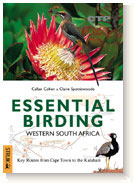
Lys and I decided that after a long gap since our previous visits to southern Africa (Zimbabwe in Sept/Oct 1986 and Apr/May 1989) it was time to try South Africa. A first attempt at a trip at Xmas 2004 was abandoned, as we left it too late and the flight prices were horrendous. So we started planning early in 2005 for a three-week trip in the autumn. We had made contact with David Winter of Birding Africa at the Rutland Birdfair in 2004, and also had good feedback about them from Rich Andrews, also based in Bristol (see CVLbirding for a report on his trip in Jan 2004). As a pelagic was top of our list of priorities, and knowing that they get booked up in advance, the first thing we did was book onto one of those. David Winter arranged this on our behalf through Cape Town Pelagics, where the contact was Ross Wanless. We booked our flights through Wildwings, flying KLM from Bristol on at 06.15 on 12 Oct, changing in Amsterdam to arrive Cape Town at 21.55 the same day. The return flight left Cape Town at 00.50 on 5 Nov, getting back to Bristol at 14.15 the same day, and again via Amsterdam. The cost was £731 each. We also arranged car hire with Europcar, at a cost of £686 for an 5-door air-conditioned Toyota Tazz, not 4x4 but fine on the dirt roads as long as you weren't in too much of a hurry.

As ever, there wasn't enough time to plan the trip properly, but I skimmed through 'Essential Birding: Western South Africa' by Callan Cohen and Claire Spottiswoode, to work out a route that I hoped would maximise the number of species without involving too much driving. In the end I think we were reasonably successful in this, though even so we did end up covering nearly 4500 km in the three weeks; South Africa is bigger than I had imagined, and we did have a couple of (for us) very long drives, taking big chunks out of the day's birding. The basic route was the triangle Cape Town, north to Lambert's Bay on the west coast, south-east to George on the south coast ('Garden Route') and back west to Cape Town. This meant that we missed out on the main desert areas of Namaqualand and the Kalahari, although we did make a couple of forays into the Karoo where we located at least some of the dry-country specialities. And of course, several visits to wineries had to be fitted in, and there aren't too many of those in the desert. Lys arranged most of those in advance through their various agents in the UK.
Having got the framework sorted out, we asked Birding Africa to handle all the accommodation booking for us, and to advise on the amount of time best allocated to each place, bearing in mind that we also wanted to minimise the number of times we had to pack up and move on. I have to say that in this (as in everything else) they succeeded brilliantly. I would have no hesitation about booking through them again – the places they chose suited us perfectly. The cost was about £1400 for the two of us, which included the pelagic, a day's guided birding around the Cape area, all the accommodation (B&B mostly, plus evening meals for the three days we spent on a remote farm in the Overberg).
The following is a summary of the high points of each day. The full list of birds seen came to 235 species of which 95 were new. If you need more information about any aspect of the trip, my contact details are on http://www.kjhall.org.uk/lpo.htm.
Up at 03.00, and although all the flights were on time, we didn't arrive at our guesthouse until 23.00, by which time our hosts had gone to bed, though they left us keys and instructions as to how to get in.
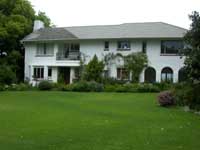
Awoke to find the sun shining, an experience to be repeated almost every day throughout the trip. The guesthouse, in Kirstenbosch, was a stone's-throw from the Botanical Gardens, and its grounds almost an extension of those. Lesser Double-collared Sunbird and Cape Francolin, my first two ticks, could be seen from the breakfast table, and I could renew acquaintance with Cape Robin, Olive Thrush, Red-eyed Dove and Red-winged Starling at the same time. Two points here: the passage of 16 years since our last trip to southern Africa, as well as the passing of the years themselves, has the embarrassing result that I could not alway remember whether each species was new or not, and necessitated a scan of the lists from the previous trips to double-check. Also, the fieldguide we used, the SASOL 'Birds of Southern Africa' by Sinclair, Hockey & Tarboton, has adopted the Sibley/Monroe classification, with all the splits and new names that that involves. It was sometimes difficult to decide whether I was seeing a new bird or an old one under a new name! In general, I decided mostly to stick with the older names, and eschew the chance of multiple ticks by ignoring what look to be fairly spurious subdivisions (e.g. all those larks only identifiable by geographical position – I exaggerate, but only a bit).
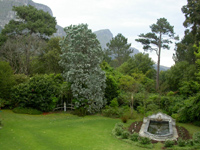
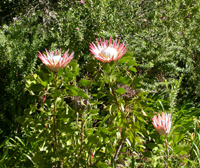
After breakfast we strolled down the road and into the Kirstenbosch Botanical Gardens and happily spent all day there. The gardens are at the foot of the back of Table Mountain, and the formal gardens, with their fantastic displays of proteas, run uphill to gradually merge with the wild fynbos (the Cape endemic heathland-like vegetation) of the lower slopes. Despite being justifiably popular with the general public (and botanists from around the world), there was no problem in amassing a good list of birds here, including our only Rameron Pigeons of the trip and a pair of Orange-breasted Sunbirds, perhaps the most attractive of what is a wonderful family of jewel-like birds.
Our hosts at the guesthouse arranged for our hire car to be delivered to us, so rather than having to get a taxi back out to the airport as originally booked, we had the morning free to spend in the gardens once more. (Also, the delivery charge was less than the taxi fare, so that was an added bonus.) This time we located a Cape Sugarbird, characteristically perched on top of a Giant Protea, so that was the world's sugarbirds 'cleaned up', after having seen Gurney's in Zimbabwe.

A passing tourist asked us to identify a couple of strange birds she had seen up in one of the tall trees in the formal gardens (why is it that they always pick on foreigners making their first visit?), but clinching our first Spotted Eagle Owls in broad daylight at point-blank range was not too difficult! We spent the afternoon on a trial-run down to Simonstown, ahead of the next day's pelagic, as, with a crack-of-dawn start, we didn't want to arrive late for that. A pleasant lunch at one of the waterfront restaurants (Bertha's) added Swift Tern, Cape and Hartlaub's Gulls to my list while we were eating, and an hour at Boulders Beach, just down the coast added Cape Gannet, Crowned Cormorant and our first 'wild' penguins. Though, as one could almost touch the African Penguins here, they were not exactly shy. But it was good to see them swimming among the breaking waves, and hear their raucous donkey-like calls, which give them their alternative name of 'jackass penguin'. They are a major tourist attraction, though the noise and smell is apparently a mixed blessing as far as the locals are concerned.

Up at 5.15 to drive to Simonstown by 6.40, so in good time for the boat which left at 7.00. There were nine of us, plus three crew, including our two leaders, Ross Wanless and Peter Ryan. Luckily it was reasonably calm, so maybe we didn't need the Stugeron tablets we took (and which sent Lys to sleep from time to time). I've certainly been on rougher pelagics, and felt fine, but some of the others looked a bit green from time to time. We sailed along the Cape Peninsula, with sightings of Southern Right Whale and loads of Fur Seals as we headed out into False Bay. Cape Cormorant was another tick as we left the harbour, but apart from the Cape Gannets the seabirds proper did not start until we got to Cape Point. But from then on, one could hardly keep up! Sooty and Great Shearwaters were numerous, and we also saw Arctic Skua and Sabine's Gull as we headed out further. All of these I had seen before, likewise the Wilson's Petrels which became more and more numerous the further out we went. The skipper located a trawler about 20 miles out, and headed for that, and we were lucky enough to be there when it hauled up its net, with the consequent maelstrom of birds looking for the by-catch. One's first albatross must always be special, and certainly the first of many Shy Albatrosses was breath-taking. This was followed by many Black-browed, both Atlantic and Indian Yellow-nosed and, best of all, a single Wandering which spent about 15 minutes around the boat. Southern and Northern Giant Petrels came near enough for us to see the bill-tip patterns, and a Subantartic Skua actually landed on the bulging trawl net as it hit the surface. White-chinned Petrels and the superb Pintado Petrels were common, and we located a few of both Black-bellied and European Storm Petrels among them. A couple of Southern Fulmars (and they do look different from our Northern ones) were another bonus, as was a passing Long-tailed Skua as we headed back in the afternoon. Peter Ryan commented that as far as the weather/sea conditions were concerned that 'it doesn't get much better than this', but as far as I was concerned the same could be said for the birds. Twelve ticks in a day, all of them seabirds, can't be bad. We drove back via the Chapman's Peak coast road to Hout Bay, one of the most spectacular coastal drives in the world. Stopping to admire the view at the far end, I looked up to see a couple of Black Eagles soaring just above the road. A local tourist had also seen them and we heard him say, 'what are those?' A passing Englishman said to him, 'Oh, they're buzzards', in that confident, matter-of-fact way one hears so often from people whose lack of knowledge is no hindrance to their expressing an opinion; although it's not normally worth bothering to say anything, it seemed a pity not to correct him over such a spectacular bird seen at such close range. The local seemed pleased to have seen an African speciality, and the Englishman was gracious enough to admit that he might have been mistaken! I could even show them both the picture in the fieldguide so that they did not just have to take my word for it.
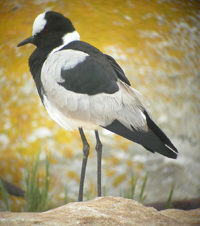
David Winter arrived at the guesthouse at 7.00, along with an American lady who was to join us for the day. As one has to keep a day free in case the pelagic has to be postponed, we booked this day's guided birding with Birding Africa to take place on whichever day the pelagic did not happen. David took us first to the Strandfontein Sewage Works (our guesthouse hosts were amazed when they found out where we had been!), a good place to go to with someone local who knows the way around. Of course, quite a few of the ducks, grebes, herons and waders I had seen before, but South African Shelduck, Cape Teal, Cape Shoveler and Yellow-billed Duck were all new, and it certainly helped to have a local to identify things like Levaillant's Cisticola for us. Greater Flamingos and Glossy Ibis are always worth seeing again, and one doesn't see hundreds of Black-necked Grebes in summer plumage every day. We continued round False Bay to the Rooi Els Cape Rockjumper stakeout, and after a bit of searching David located a pair of these for us. They were high on my 'wanted' list, and again fulfilled every expectation, even better for the fact that they were to be the only ones we saw on the whole trip, so 'thank you, David' once again. A pair of Cape Rock Thrushes were another nice find, and we renewed acquaintance with Rock Martin, Familiar Chat and Neddicky as well as adding Grey-backed Cisticola to the list. The Harold Porter Botanic Gardens produced our first Sombre Greenbul, a life tick rather outshone by the previously seen African Paradise Flycatcher and Cape Batis in the same tree. The American lady was as pleased as us with the day's birding, especially as she had cancelled a day's tour the previous day after a short time as apparently the guide was hopeless. So not all bird-guides are the same – be warned.
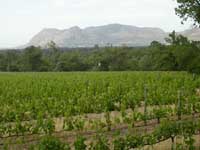
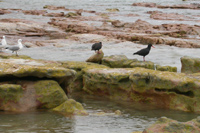
It was time for Lys to take over, and so we headed to the nearby wine estate of Groot Constantia, where we had a personalised tour of the site with the marketing director, followed by an extremely comprehensive tasting. The only bird we saw at the winery was the introduced European Starling (like House Sparrow, another of Cecil Rhodes's contributions to the South African avifauna, nowadays common and widespread). But we noted that a previous visitor, in the 18th century, was the French naturalist, François Levaillant, he of cisticola (etc.) fame. His African mistress was apparently called Narina, for whom he named the trogon of the Garden Route forests (we dipped, in case you want to know in advance!). We decided that we really ought to fit in Cape Town itself at some time, so spent the afternoon at the Victoria & Alfred Waterfront development of up-market shopping malls, bars and cafés, all very swish and nice, with views of Table Mountain that looked somewhat more like the postcards than the views we had had so far from the Kirstenbosch side. Nevertheless, a stroll to the harbour breakwater added two more lifers – Cape Sparrow and African Black Oystercatcher – a strange place to see what is one of the rarest waders in the world with a total population of fewer than 5000 individuals, all found along the coasts of the southern tip of Africa.
This morning saw us in the 'Constantia Greenbelts', fragments of the original forest that have survived the encroaching (posh) suburbia of Constantia and Kirstenbosch. You can explore the tangled streamsides along public footpaths, but need to take care not enter the nearby gardens (assuming you could get over their fences) where dobermans and alsatians roam, and they employ security firms called things like 'Armed Response'. Nothing new found here, but a calling Burchell's Coucal showed well, as did Common Waxbill and Cape Grassbird, and hearing a familiar song led us to a nice male European Chaffinch, another of Cecil Rhodes's imports, and apparently not seen by every visiting birder. On to Kommetjie, on the west coast of the Cape Peninsula where we located a few Bank Cormorants, so another endemic under our belts. We were going to explore the Cape Point Reserve, but this was where it started to dawn on us that, however small Cape Province looked on a map of Africa, it was still a pretty big place by European standards, and we would have to trim our ideas if we weren't to spend all our time on the roads. So we pottered back to Scarborough for another seafood lunch, and made do with Malachite Sunbird, Yellow-rumped Widow, Cape Canary and Black-shouldered Kite along the way. Tough. Kommetjie at high tide produced an African Darter and a Pied Kingfisher, not quite what we expected on a coastal site. In the evening we were invited to a mega-cocktail party thrown by our guesthouse hosts, one of many examples of the hospitality we received everywhere from South Africans on our trip.
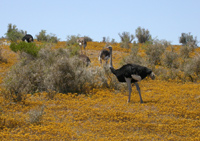
Time to move on, but we decided that a pre-breakfast revisit to the Constantia Greenbelts would be worthwhile, which it certainly was, with sightings at last of African Sedge Warbler (only heard yesterday) and brief, but adequate, views of the elusive Knysna Warbler, a good one to get on our own. So farewell to Kirstenbosch, and north out of Cape Town along the west coast main road, stopping briefly at Bloubergstrand from where one should get the most famous view of Table Mountain, but today it was completely obscured by the 'tablecloth', reaching nearly down to sea-level. Tant pis – another time. 'Essential Birding' gives a variety of sites worth checking along this coast, not all of which can be fitted in on a trip like this, but we tried a few of them. The open country of Silverstroomstrand produced our first Ostriches of the trip (feral, no doubt, but who cares – they didn't feed from the hand, at any rate), plus Bokmakierie (high on my wanted list) and a distant Black Harrier. Also several Steppe Buzzards, though I couldn't see much difference between them and the birds I see at home in Somerset. We turned off the main road and followed what was to be the first of many drives along unsurfaced tracks – this one, over the Darling Hills, proved particularly outstanding. We soon had a much more satisfactory view of a Black Harrier close to the road – they really are striking birds, and one can quite see why Birding Africa chose them as their logo. After a short period of quartering the fields in typical harrier fashion, it zoomed up into the sky to start chasing first a Yellow-billed Kite and then a pale-phase Booted Eagle, all three disappearing into the distance together. Soon after this were our first Pied Starlings, invariably in flocks of one size or another. A scan of the open scrubland located a Southern Black Korhaan stalking through the grass whilst a touch of home was brought by the many European Bee-eaters on the roadside wires, and the African Hoopoe (distinctly darker than our bird) that flew in front of us.

Nothing, however, prepared us for quite how stunning we would find South Africa's national bird, the Blue Crane. A small party of five were stalking across the grassy slopes at the top of the hill a short distance along the track, each one a mist-blue picture of elegance. Armani would have been proud to design something half as refined! This first group put on a wonderful show for us – dancing, calling and then flying overhead – and although we saw quite a few more during the rest of the trip, we invariably stopped to admire them. The track continued through varied farmland and bushy riverside vegetation, with constantly something new to see, too much to list here. A pair of Fiscal Flycatchers conveniently perched next to a Fiscal Shrike, just to make the identification of what are similar-looking although unrelated species that much easier. Although seemingly miles from open water, a squadron – well, four birds – of White Pelicans were easy enough to spot overhead. This was one of several species that I did not realise was new until much later; I'd forgotten that I had only seen the similar-looking American variety before! How can that happen?
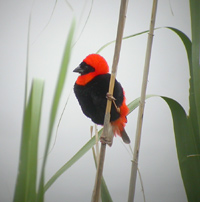
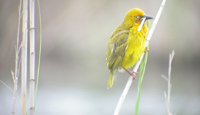
A passing 4x4 stopped while we were admiring another group of Blue Cranes, and the driver turned out to be the owner of the Groote Post winery, the turning to which we had just passed. He said that we were very welcome to go and look at his personal bird reserve, which lay just beyond the winery itself. Groote Post was not on Lys's list, but we thought, carpe diem, why not, so took the detour to reach a reed-fringed lagoon, infested (if that's the right word) with Red Bishops and both Cape and Masked Weavers, a cacophony of scarlet, yellow and black. An African Reed Warbler crept about at close range, just an LBJ, but still a welcome tick. It seemed churlish not to go and sample the local produce so, narrowly avoiding a group of White-rumped Mousebirds dusting on the road, we stopped for a tasting of several of their wines – very high quality from one of the lesser-known wine regions of South Africa. We bought a few bottles, and were loading them into the car when the owner reappeared. We thanked him for allowing us to look at 'his' birds, and admitted that Lys (aka Grape Escapes) was in the wine business herself. Cards were swapped and, on discovering that we were on our way to Langebaan, he asked us to deliver three cases to the local supermarket to save him the drive. A bit of a busman's holiday, then, but a nice example of local friendliness – I guess we must look honest (though he knew where we were staying!). Trying not to stop too often – we could have spent days along this track – we eventually regained a surfaced road and headed on quickly north through Darling to get to Langebaan and our guesthouse before it was dark. Celebrated an excellent day's birding at Pearly's beachside restaurant.
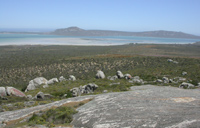
Having made our delivery of wine and stocked up for the day, we headed into the West Coast National Park, and the Seeberg hide which overlooks the northern end of the huge shallow Langebaan lagoon. Tortoises of various shapes and sizes diced with death on the road – luckily the traffic density was low enough for us to take avoiding action – and we also saw a Small Grey Mongoose running off into the undergrowth and a Four-striped Mouse eating berries in a roadside bush. A large black snake among the dunes was rather more worrying – we watched it from what we trusted was a safe distance, but never came to a conclusion as to species or venomisity. We spent the day viewing the lagoon from various vantage points along the east side and around the shallow southern extremity. Karoo Scrub-Robin and Yellow Canary were both new among the passerines, whilst the wader flocks out on the mud held such familiar migrants as Curlew Sandpiper, Little Stint, Ringed Plover, Greenshank, Sanderling and Whimbrel. It's always rather special to see these Arctic breeders so far from home and to reflect that they got here under their own steam with minimal effect on the earth's atmosphere, unlike our own jet-assisted journey. The Geelbek hide at the southern end was excellent around hide tide, with many waders (the Marsh Sandpipers were impressive) coming extremely close, though the walkway out was rather rickety in places – be warned. On the land, birds were thinly spread, but any patch of standing water usually produced something, including a nice African Spoonbill and more Kittlitz's and White-fronted Plovers. We returned via the Seeberg hide and in the evening 'Essential Birding' came up trumps again with a covey of Grey-winged Francolins just where the book said they should be!
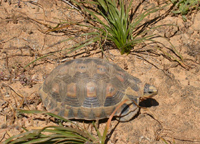
Today's morning route was a bit of a repeat of yesterday's, but we had a more accurate idea of the tides, and so got better views of the waders. Southern Grey and Cape Penduline Tits were both new birds, and we were by now becoming reasonably au-fait with the commoner small birds of the bushy habitat here, and so could concentrate on the less familiar ones. It was a good area for Black Harriers, and we also located an African Marsh Harrier quartering the reeds at the southern end of the lagoon. After lunch at the Geelbek manor house visitor centre we walked through the saltmarsh to the south to overlook a brackish lagoon where 61 Lesser Flamingos mostly kept their bills hidden and so took a bit of time to clinch; there was not a single Greater with them, although there were plenty out on the main saltwater lagoon. I guess the African (or is that Grassveld) Pipit was a new bird, but it was Richard's when I was in Zimbabwe, and then I'd already seen that in Europe – these taxonomists have a lot to answer for!
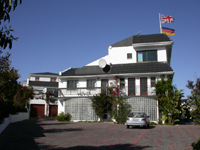
As we had had to rush past on the way up, we decided to head south out of the park and back to the Tienie Versfeld reserve, north of Darling, a remnant of the native grassland which has mostly elsewhere been replaced by cereals and ranching. The visit was complicated by the fact that the entrance was now halfway along several miles of roadworks with traffic lights at either end, on a quarter-hour cycle, but well worth the struggle just for the wildflowers, even this late in the season (September is better from a botanical point of view). We caught up with Large-billed Lark here, as well as the minuscule Cloud Cisticola for which the reserve is a well-known stake-out. It took a bit of finding, as its song period appeared to have stopped for the day, but watching an Orange-throated Longclaw was a pleasant way of passing the time while waiting for one to emerge and chase an intruder away. We even managed to see a Quail in flight, rather than just hearing them calling. Driving back through the West Coast reserve to Langebaan (they'll let you back in again on the same day-permit, as long as you keep it with you), we had excellent views of a Black-shouldered Kite (quite numerous in this area) eating some unfortunate rodent, and then the remarkable sight of a Spotted Eagle Owl perched on a roadside bush in broad daylight.
Time to move on once again, this time north via Vredenburg to Paternoster, with a few detours into the farmland where Sickle-winged Chat ('remarkably common' according to Essential Birding) proved impossible to find (well, one has to save something for next time!) but a pair of Grey-backed Finchlarks kept the list on the move. A large damp area in the farmland on the way to St Helena Bay produced our only Spur-winged Geese of the trip, along with over 30 Blue Cranes and 50 Egyptian Geese (these were seen almost everywhere during the trip, often miles from water). Capped Wheatear and Red-capped Lark (another retrospective tick, it appears) were omnipresent in the farmland from now on, at least until we left the west coast. At Velddrif, a bit of a one-horse town, but with a welcome bar serving nice cold beer, we explored the Cerebos saltpans both from tracks round the fringes and then within the barriered-off works themselves, having been let in by the security guard with no problem, though access was only allowed on foot. Sacred Ibis, both flamingos, Black-winged Stilt and Avocet, plus a small selection of the commoner waders were on offer, but it was a bit too smelly and insect-ridden to linger here for very long. Birds became a bit more scarce as we headed on up the coast road via Dwarskerbos, though our first Jackal Buzzard on a roadside telegraph pole could hardly have given better views. The tarmac soon finished, and then it was unsurfaced roads all the way to Eland's Bay, with the sea not far away, and the countryside almost devoid of habitation. We really loved this stark west-coast landscape, empty and wild, dramatic despite the absence of the mountains to be found elsewhere. It was ranching country, with lots of cattle and sheep (and Cattle Egrets), and we at least managed to locate Ant-eating Chats, even if the Sickle-winged eluded us.

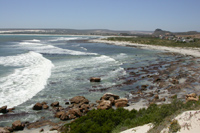
The road passed the huge inland lake of Verlorenvlei, with white drifts of Greater Flamingos dominating a rich collection of other waterbirds feeding close to the road. A troop of Chacma Baboons crossed the road in front of us, to remind us we were in Africa, and we continued along an inland loop, a short section of which was tarred, before reverting to gravel most of the way to Lambert's Bay. A Pale Chanting Goshawk with prey flew across the road, so that was another family 'cleaned up'. At the Lambert's Bay Hotel we found that we had been put in the enormous 'Lambert Suite', presumably because Birding Africa had found the hotel otherwise fully booked – some sort of religious convention seemed to have taken over the rest of the place, it appeared. The staff at the hotel quietly suggested that we might have a more enjoyable evening meal than we would with them if we went round the corner to the Die Kreefhuis restaurant, which was thoughtful of them. And so it proved, as their fish was excellent, and the atmosphere tranquil.
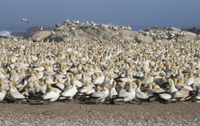
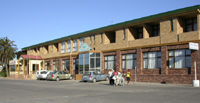
To avoid the hordes, we decided on a pre-breakfast visit to Lambert's Bay's main tourist attraction, the thousands of Cape Gannets at their colony on an offshore islet, now linked to the mainland by a causeway. The sight (and smell) is certainly arresting, and the little museum is well done, too, with its history of the guano industry which, together with the fishing, was the basis of the local economy in the past. There were large numbers of Cape Fur Seals at the far end of the island, with Swift and Common Terns among the Hartlaub's and Cape Gulls in the harbour. The coach parties were leaving as we returned to the hotel for breakfast, having almost stripped the place of anything edible – gannets, indeed. We aimed to return to Eland's Bay today, and found that the local garage could sell us a ticket for the toll-road which runs parallel to the coast (and railway) and saves quite a long loop inland. Maybe one could pay the chap on the gate, but there's no harm in being prepared. The other advantage of this route is that it goes right next to Wadrifsoutpan, where there was a nice mix of waders including, outstandingly, a pair of Chestnut-banded Plovers, which we had given up hope of, not having located them at their main stake-out at Velddrif.
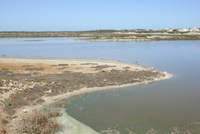
At Eland's Bay we admired the wonderful view of the breakers and beach from the road to Baboon Point, then headed south, back to the Verlorenvlei. The by now familiar grebes, ducks, flamingos, pelicans, egrets, herons, ibises, coots (alway Red-knobbed, of course) and waders kept us busy, and we could add Caspian Tern to our list for Africa as well as Europe and America – a widely, if thinly-spread species indeed. We then ventured a little further south along the coast road to a vantage point where the rolling ranchland could be scoped, and eventually I located two huge, if rather distant, Ludwig's Bustards, slowly stalking through the open grassland along with plenty of Ostriches and Cattle Egrets. We ate that evening at the hotel restaurant, in almost solitary splendour, with the staff delighted to see us.

Woken by the sound of the resident Little Swifts and Rock Pigeons, both of which were nesting on or near the hotel, we packed up, took one last look at the Cape Gannet colony and the desolate coast stretching north towards Namibia, and headed off inland. Lys had arranged for us to visit the Stellar Organics winery at Trawal, about 60 km away to the north-east, originally as a day-trip from Lambert's Bay until we realised quite how huge South Africa was. This was not the last visit that would have to be rearranged for similar reasons! We were due there for 10 am, and the first 30 km to Graaf Water on tarred roads was no problem. But from here we had to decide between a further 70 km drive on surfaced roads via Clanwilliam, or 30 km of possibly unsurfaced roads across country via Ratelsfontein. We plumped for the latter, and arrived only a quarter of an hour late, the roads turning out to be dirt tracks the whole way, and the signposting fairly minimal. Luckily the railway line was not far away, and gave us some confidence that we were going in roughly the right direction. Wonderful scenery along the route, but few birds – difficult to keep the car on the road and watch birds through the dust at the same time.

We were met by Willem Rossouw, the owner and, together with a journalist from Cape Town, we were given an extremely comprehensive visit, and a wonderful lunch and tasting at Willem's house. The winery is not only 100% organic, producing both wine and table grapes, but is run on FairTrade lines, so that a proportion of the income goes direct to the workers for them to spend on collectively decided projects. As well as seeing the winery itself we got bounced round the vineyards on the back of a truck, along with the vineyard manager, to get close-ups of the wildlife that thrives under organic-production conditions – lots of insects busily working away around the naturally mulched rootstocks, and francolins, bishops and other birds feeding among the vines. It's worth adding that we've visited many vineyards on our travels, and it's sad to report that many of them are ornithological deserts owing to the intensive way so many are managed. We also had a presentation from each of a dozen of the workers in turn, each explaining their particular role, and the training they were receiving. Although the owner was a white South African and most of the vineyard workers were black (and/or 'coloured' – the distinction meant less to us than to the locals), it appeared that the training was designed to lead to the staff taking an active role in the management of the winery in the not too distant future; some were managers of significant parts of the operation already. What made the presentations even more impressive – and imagine being summoned off the 'shop-floor' to explain what you do to a collection of total strangers from the other side of the world – was that most of them did so in their second language, English, for our benefit. Outside of Cape Town, we found that Africaans was the language spoken by the majority of whites and most of the black people we met, though everyone would swap into English for us. We were also taken to see the workers' houses nearby and their neatly kept gardens, and then to Willem's house for lunch – as so often on this trip the hospitality was first-rate. From our side, we felt that by having driven across-country to get there, by looking askance when rampaging elephants were mentioned as a vineyard problem, as well as agreeing to travel in the back of a farmtruck, we did something to persuade the locals that not all English tourists are naive wimps, a seemingly common belief! It wasn't until 16.45 that we could get on our way again, complete with a few more samples for later, with a 200 km drive ahead of us via Clanwilliam, over the spectacular Piekenaarskloof Pass to the open farmland of Portville and on through the rocky Mitchell's Pass to Ceres, where a welcome evening meal and bed awaited us. At least the whole of this part of the route was surfaced and, as everywhere, the density of traffic was extremely low by European standards.
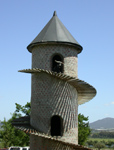
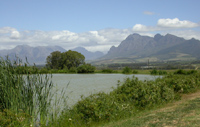
From Ceres we drove back down the rocky ravines of first Mitchell's and then Bain's Kloof passes. The scenery was spectacular but by now most of the birds were familiar ones. Another winery visit beckoned, this time at Fairview, south-west of Paarl. They seemed to have forgotten we were coming, but soon made amends as the marketing manager emerged from a meeting to give us a whistle-stop tour of the cave, followed by an invitation to taste as many wines as we liked. They also specialise in goats' cheeses, hence 'Goats do Roam', 'Bored Doe' and similar names to sell at least some of their range of wines. Whatever you think of the marketing, there's no doubt that the quality of many of them is excellent. Fairview has diversified into tourism as well, with tastings available to the public, a gift-shop, a restaurant, and wonderful views to the surrounding mountains.
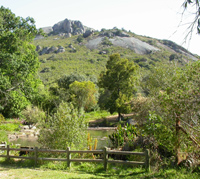
After lunch we headed up into one of these, along the Jan Phillips Mountain Drive, a rather rough track north from the impressive Afrikaans Language Monument along the side of Paarl Mountain. Fortuitously, we found the wildflower reserve and botanical gardens that have been established here – although they are mentioned in Essential Birding, I just hadn't got that far in the book until the evening! Nevertheless they were well worth stumbling on 'by accident' as it were, with Cape Sugarbirds and Malachite Sunbirds, Cape Canary and Fiscal Flycatcher all seen at close range. We pottered on along the Mountain Drive, when a series of mournful calls drew my attention to a smart black-and-white bird close to the road – Southern Boubou, at last, so that's all the South African boubou-shrikes 'cleaned up'. It's always good to get a new bird on one's birthday, and as a bonus we spotted a Black Saw-wing Swallow as we drove back through Bain's Kloof to make it two for the day.

The reason we had chosen Ceres as a base for a few days was to give us the chance to get to grips with at least some of the semi-desert birds of the Tanqua Karoo, an offshoot of much more extensive similar habitat further north and east. Heading north-east from Ceres though rolling farmland, as ever with wonderful views all round, the tarred road turns to dirt at the Karooport pass, where the road from Touwsriver comes in. We worked our way slowly along the rocky pass, but although there was plenty to see, the hoped-for Namaqua Warblers eluded us. Once through the pass it was out into the extremely hot flat bushland and rocky semi-desert of the Karoo proper.

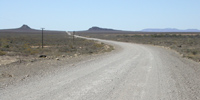
We got as far as Eierkop, where the Karoo Eremomela stake-out produced the goods – actually rather prettier little birds than the fieldguide gives them credit for. We decided that it was just too hot and dusty to continue further, but this stretch had already produced a good list of local specialities – Mountain Wheatear, White-throated and Black-headed Canaries, Karoo Chat and the rather elusive, if attractive, Fairy Flycatcher. We grilled all the Red-winged Starlings but could not convince ourselves that any were Pale-winged, although some were possibles. We also located our only Chestnut-vented Tit-babbler of the trip, grovelling about in the roadside scrub.

Having now read the next few pages of Essential Birding, we decided that we ought to do Paarl 'properly', but when we got there we found the Mountain Drive was closed for tree-felling! So we continued to the Paarl Bird Sanctuary, actually part of the town's sewage works, but with several hides overlooking a series of shallow lagoons, all of which can be accessed by car. We spent an excellent couple of hours here, and although nothing was actually new, we rattled through a whole series of species that we did not see elsewhere.
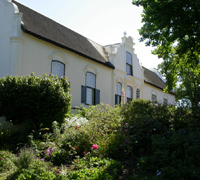
I suppose the star bird, certainly for the locals, was the Goliath Heron, here a vagrant well south of its normal range. Of course 'vagrants', when so many birds are new anyway, never have quite the same cachet for the overseas visitor, but it was a fine bird to see, certainly not another boring LBJ. Talking of which, there were plenty of Cape Reed Warblers to look at, and we added Black Crake, Whiskered Tern (in summer plumage!) and Giant Kingfisher to the trip list. We also saw the back of what we assumed was an African Clawless Otter swimming along the edge of the reeds. The sewage mixing enclosures, with their fountains of swirling brown liquid, failed to produce the promised Water Dikkops, but I have to admit we did not linger too long to look for them here. We took lunch in the far more attractive surroundings of Boschendal, with its manor house, vineyards and gardens, the sort of place the National Trust would be proud to own. We headed on to Stellenbosch for a quick circuit of the town centre – there's never enough time to do it all – before heading back to Ceres again.
Time to move on once again, bidding farewell to another couple who had provided excellent evening meals every night, as well as B&B – after long days out it's always nice not to have to venture too far in search of food.

The old Tollhuis cafe a short way down Mitchell's Pass seems to have been vandalised, so we decided it was not a good spot to explore in much detail, though we did see a couple of Black Eagles overhead. Having seen both African Black Duck and Three-banded Plover the previous evening at the Darling Bridge, by the Wellington/Worcester road junction, we spent a little time here, but to no great avail, so we continued on through the open farmland of Worcester to reach Robertson, which gives its name to the wine area we were about to visit. Between the two towns the road ran though a wilder stretch of scrubland and although the road and railway were intrusive, as you could not easily get away from either, we did manage to see a dark-phase Booted Eagle and a pair of Jackal Buzzards here, plus our first Red-faced Mousebirds of the trip, to complete the set, as it were.
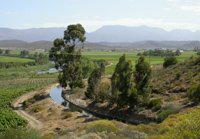
We were booked for a visit to the Weltevrede winery, nominally 'Robertson' but actually considerably further on near Bonnevale. However, we weren't late, and again enjoyed a bumpy trip round the vineyard in a tractor-drawn carriage, including a tasting of their sparkling wine taken right next to the vines where the grapes from which it was made had been grown. A nice touch. Another representative tasting and an excellent lunch followed. No chance of losing weight on this trip. After this it was time for another long drive, 250 km, via Swellendam, Heidelberg and past Mossel Bay to George. The guesthouse was well signposted, and it wasn't far to walk to a batch of restaurants for an evening meal. The Italian one recommended by our hosts was full, so we reserved a table for the following evening and had a pizza at the pizzeria next door. We discovered that even the smallest South African pizzas are too big for us to consume in one go, but they are happy to provide a 'doggy-bag', so that was tomorrow's lunch sorted.
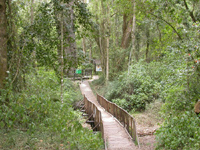
After such a long drive the previous day, we decided that we would not venture too far today, so we headed east along the modern road that sweeps its way though a series of wooded curves to Wilderness and the start of the famous Garden Route. Certainly the view from the road of the Indian Ocean beaches was impressive, but it did look as if, how shall I say, other tourists had discovered the area before us. The Wilderness National Park was attractive, but not exactly wild, and the adjacent lagoons looked a bit 'tame' after what we had seen before. No doubt we are being a bit unfair, and we didn't get very far along the coast (not even to Knysna), but the bleak west coast had more of the sort of scenery we had come to Africa to see. However, having picked up some details from the Wilderness tourist office, we headed inland to the 'Big Tree' reserve at the edge of Woodville Forest.
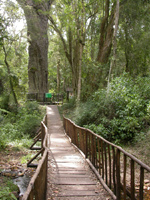
The reserve takes its name from a giant Outeniqua Yellowwood tree, not far from the start of a 2 km circuit through the lush forest habitat for which this coast is famed. Finding forest birds is never easy, as you have to wait ages at each spot to see what will (eventually) move or call, but we were very happy in the end to spend all day here. Several of the species we saw we had seen previously in the forests of eastern Zimbabwe (another favourite spot), but the Chorister Robin which came and landed right next to us was new, and located so much more easily than I had thought possible, remembering how hard it had been to see Swinnerton's and Starred Robins in the Vumba.
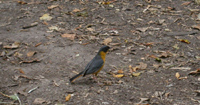
Greater Double-collared Sunbird was distinctly bigger than the Lessers we had seen so frequently up to now, and we sometimes saw the two species together here. As ever in the forest, you see nothing, and then a whole string of different species all together. A Black-headed Oriole and three Red-billed Woodhoopoes led us to another new species in the form of a pair of Grey Cuckooshrikes, the whole group all together up in the mid-canopy (forest birding isn't too good if you have a bad neck or stiff back). A flash of purple wings and a crashing of branches drew our attention to a Knysna Lourie which was methodically picking off berries high up in the canopy. Was this a new bird? According to the SASOL guide it now seems that the birds I saw at Victoria Falls were Schalow's Louries and those in the Vumba were Livingstone's, so suddenly I have three ticks instead of one. I think, however, I'll stick with the Birds of Africa and be satisfied with a single tick for what is a beautiful bird, even if isolated populations are prone to slight variations in plumage.
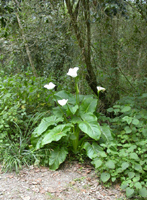
We spent the morning pottering about in the shade and then I took a short stroll along the entrance track to where a patch of rough ground provides a good vantage point for scanning the wooded slopes from a distance. Also scanning the woodland was a single Forest Buzzard, perched at the top of a conifer, conspicuously showing the white patch in the centre of its breast, just like the fieldguide. On the way back to George we had a quick look at some of the lagoons of the Wilderness park, but myriads of Red-knobbed Coots and a few of the commoner ducks and grebes were the only birds to be seen from some rather awkwardly designed hides, the flaps opening outwards and hence disturbing the birds even more than opening them usually does. The Italian restaurant (La Capannina) in George was excellent – one can see why they get booked out.
Decided to head inland today, on the wide modern road over the Outeniqua Pass to Oudtshoorn, the world's Ostrich-farming capital, it seems – certainly there seemed to be more Ostriches than people on the way there. Then on via Grootkraal and over the Groot Swartberg hills via the Swartberg Pass, mostly on some pretty rough gravel (26 km in all) with steep slopes either side. We stopped at all the 'streams' on the way up, but the hoped-for Protea Canaries proved elusive and we had to make do with Malachite Sunbirds and Cape Sugarbirds. We didn't linger at the pass itself as there was a howling gale up there, but quickly headed down through a series of barren gorges with tortuous twisted exposed rock formations to the start of the Great Karoo lowlands.
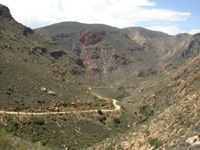
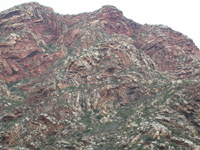
The gorges produced both Red-winged and, at last, Pale-winged Starlings, the latter alone justifying the long drive; the derelict campsite just before the tarred road began again provided us with excellent views of another speciality, a pair of Pririt Batises, which had also eluded us on the Tanqua Karoo. An Acacia Pied Barbet was a reminder of days in Zimbabwe, another 'common resident' that we only saw once on this trip. Then back over the pass and down the slopes on the southern side once more, stopping to scope a distant passerine on the top of a rock – a Sentinel Rock Thrush this time. Rather tamer were three Klipspringers on a some roadside boulders, rounding off an excellent day and some wonderful scenery.
After so much driving (and more ahead of us) we decided that we would return to the Big Tree reserve, and again work our way round the forest trail to see if we could find anything new. Which we did almost immediately – a single Forest Canary feeding quietly in the mid-canopy, perhaps not the most exciting bird in the world, but they all count. A Red-chested Cuckoo landed briefly by the path, staying just about long enough for us to be sure of it before it flew off. We had added Olive Woodpecker to the list on Saturday, but this time we found a nest, amazingly enough right by the path, in the stump where people are encouraged to carve their names, if they feel they have to, rather in the 'Big Tree' itself. The bird disappeared in and out of a hole at the back of the stump in typical woodpecker fashion, ignoring the passing visitors. Another slow stroll round the trail gave us better views of most what we had seen previously plus a Green-backed Bleating Warbler to keep the list on the move. The picnic site near the entrance was as good a spot as any, and the Chorister Robins were obviously used to picking up crumbs here – one even landed on Lys's shoulder briefly! By just spending the time sitting here quietly, we obtained close-up views of Terrestrial and Sombre Bulbuls, Olive Thrush and Yellow-throated Woodland Warbler among several other elusive species.

Time to move on again from yet another excellent guesthouse for a long drive west via Mossel Bay and Riversdale to Heidelberg. Not much time to stop, even for the five White Storks flying over the road between the last two towns – amazing that they fly as far south as this from Europe to spend the winter. In Heidelberg we managed to avoid getting arrested for parking facing the wrong way by the kerb-side – it pays to be polite to policemen carrying guns – then took a rather devious route across country with minimal signposting to eventually reach the Grootvadersbosch reserve at around midday. Here it was very hot and muggy, despite the strong breeze, but the 40 ZAR entrance fee was well worth it just for the views of the wooded valley and fynbos-covered hillsides. We only had time to explore a fraction of the woodland, including a couple of nice tower hides, and the birds were clearly also feeling rather subdued. The song of the unseen Red-chested Cuckoos was distinctive enough, just from the description in the fieldguide, but was that soft repeated call far off in the forest actually a trogon? That's when a local expert would prove his or her worth, unless one carries a recording of everything with you (some people do, I know, but I think life's complicated enough without that). On again via Suurbraak to Buffelsjagrivier for a much-needed beer, with rolling green mountains stretching away on our right all the way, like the Scottish Highlands but on an even grander scale. From here it was back to gravel roads and the start of the Overberg farmlands – Blue Cranes, Steppe and Jackal Buzzards and Grey-winged Francolins once again.
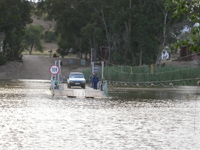
At Malgas we had to cross the river by ferry, one operated solely by the power of two men (sometimes just the one), the last such ferry in South Africa, apparently. The ferry consists of a platform big enough to take three cars (us and a truck on this occasion), linked to a cable across the river. The two men throw a chain around the cable and walk from one end of the platform to the other, pulling hard, and the platform slowly moves across. They then walk back along the platform, and repeat the operation over and over, until about 15 minutes later the platform reaches the other side and you can drive off. It's very peaceful to watch, but the guys doing the pulling must be extremely fit! Luckily traffic density is quite low, but nevertheless it's best not to be in too much of a hurry.

As our Birding Africa directions assumed we would have been approaching from the west, we were not entirely sure that we would be able to locate the farmhouse where we were to spend our last few nights, but the signposting proved perfectly adequate, and we arrived in good time, even seeing a Black Harrier along the entrance drive. Our cottage was sparsely but comfortably furnished in period style, and our evening meal soon arrived, carried over from the main farmhouse about 200 metres away. Outside the darkness of an African night fell over the silent countryside, here miles from the nearest town, and it was not long before we too fell into bed.
Mind you, it wasn't the most peaceful of nights as it turned out, as a howling gale sprang up part way through, causing a certain amount of structural damage, and also stripping the stubble of the cut straw, much to the annoyance of the farmer as apparently he likes to leave it lying between the furrows as a mulch to stop the ground drying out too much. The wind continued to blow very hard all day, and in fact this was the only time when the weather interfered with our birding to any significant extent. Apart from today, the weather was warm and sunny almost throughout the trip, with variable amounts of cloud and next to no rain – we couldn't have asked for better. Today, even before breakfast, I had spotted a few distant Cape Vultures even a kilometre away – there wasn't much else they could have been. Because of the wind, we decided that the best bet would be to head for the main De Hoop Nature Reserve, not far away to the west, although the dust storms along the roads made driving there tricky. In the reserve it was easy enough to see the Cape Mountain Zebras, Bontebok and Chacma Baboons, but as far as the birds were concerned it was only possible to hold one's binoculars steady enough by staying in the car. However, we bounced our way round some of the rough tracks through the reserve, and managed to identify an (Agulhas) Clapper Lark, though the photo in Essential Birding was of more help than the fieldguide, and had brief views of other small birds in what, under better conditions, appeared to be a productive area. There was little to be seen on the storm-lashed vlei, so we drove as far as Koppie Alleen through the low-lying coastal fynbos where, again from the shelter of the car, we found a Long-billed Lark, again of the Agulhas variety. As, during our travels, we did not locate any of the other varieties of either lark, we were at least spared the decision as to how many more ticks they would have made. The shoreline here is certainly worth the drive and, despite the sandstorm raging along the pure white coastal dunes, we managed to see the back and tail-fin of at least one Southern Right Whale just offshore – on a calm day what an idyllic spot this must be.

As car-borne birding was still the order of the day we took off on one of the recommended circuits through the farmland to the north of the reserve, producing a mixture of species we had seen before, including the Blue Cranes of which we never tired, but nothing new, apart from much closer views of Cape Vultures overhead. In the end, I decided that the mixture of farmland close to where we were staying looked as good as anywhere we had seen on this loop, a view perhaps confirmed by the sight of a magnificent Denham's (aka Stanley's) Bustard flying over the approach track as we returned to the cottage! By scanning the surrounding slopes before our evening meal arrived, I managed to locate two more distant birds stalking through the grassland and newly-cut stubble.
Although it was still a bit breezy first thing, the weather was almost back to 'normal' today so, encouraged by yesterday's bustard we pottered slowing down the farm's entrance road track, working our way through the various larks and Capped Wheatears before eventually finding a Long-billed Pipit, and watching it long enough to be able to distinguish it from the very similar African Pipits we had seen previously. Under today's prevailing calmer conditions a Long-billed Lark performed its distinctive short display flight for us and perched obligingly on one of the bales of straw littering the fields. We headed into the eastern entrance to the reserve today, towards the Potberg, passing many more Ostriches, but also yet more Bontebok, perhaps one of the most beautiful of the African antelopes.

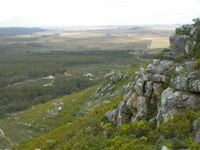
The 6 km 'Klipspringer Trail' provides a circuit of the fynbos and cliffs of the Potberg mountain, and the farmer's wife assured us that she regularly took it with her two small children. Well, all I can say is that South African children must be pretty fit, as there were times when we thought we were going to expire on the mountainside, and also when we were not sure quite where we were supposed to be going, despite the waymarking. The eucalyptus woodland at the foot of the slope produced very little, but Cape Sugarbirds performed well in the fynbos, along with Cape Buntings and Cape Canaries. The enforced wait at the look-out point, while we recovered from the climb up, meant that we had plenty of time not only to admire the view, but to watch the Yellow-billed Kites and Cape Vultures drifting low overhead, joined briefly by a Martial Eagle – a very pleasant surprise this far south in Africa. The least well-marked part of the trail is where it crosses a steep rocky gully, but here we caught up at last with two birds that had eluded us up to now, Cape Siskin and Ground Woodpecker, the latter giving prolonged views perched right on top of a large boulder. A Yellow-rumped Widow displayed to his mate, who looked considerably less impressed than we were. Thankfully it was mostly downhill from here and just as we were crossing the eucalyptus forest, an slight movement betrayed a Knysna Woodpecker, which we had missed at every previous stake-out. Before heading for home, I had one last thrash through the fynbos and at last located another Orange-breasted Sunbird, the first since our days at Kirstenbosch – it's strange how some species are so elusive while others give themselves up so easily. But, like the cranes, one can never tire of seeing such a beautiful bird. Back at the farm an evening's scan of the hillsides produced more distant views of the Denham's Bustard and then, actually visible from the kitchen window, a pair of Karoo Korhaans quietly feeding together in the first meadow outside the farm fence.
Calm and sunny this morning, and warm enough for us to have breakfast on the attractive terrace of the main farmhouse, with Malachite Sunbirds and Cape Robins for company. The Secretarybird that apparently nested close by never showed itself during our stay, but the korhaans and bustard were again visible, and a couple of Blue Cranes flew over while we were packing up. Today we had to get to Hermanus by early afternoon for another winery visit, but we decided that there would still be enough time to go the 'wrong way' first, even across the Malgas ferry and back again, to the Horus Swift stake-out on the north side of the Breede River that we had missed on the way down (again, I hadn't had time to read Essential Birding properly!). With five men working the ferry today, we were over in 10 minutes, but although on the far side we located the sandy riverbank with a few promising nest-holes, there were no swifts to be seen. Maybe it was a bit too early, or maybe they have moved on? A Burchell's Coucal and Bokmakierie kept us amused while waiting, and a group of Pearl-breasted Swallows landed long enough to be identified and ticked. Two visits to Zimbabwe and most of one to South Africa over before we pin this widespread species down! The riverside vegetation at the ferry on the way back gave us close views of a Willow Warbler, silent but seen well enough to be sure of and another bird a long way from 'home'. Then it was on west as fast as we dared on the seemingly endless gravel roads to Bredasdorp where thankfully the tarmac began and we could put our foot down and head on via Napier and Stanford, through yet more spectacularly beautiful landscapes, to the sea again at Hermanus. We arrived a mere five minutes late for our appointment at the Hamilton-Russell vineyard high up overlooking the town, and once again were given a fascinating tour and wide-ranging tasting by the owner of what is one of the better-known (in the UK anyway) South African wineries. Also visiting were a group of Icelandic wine buffs – ironic that they should be here at one of the world's whale-watching centres, we thought.
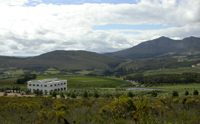
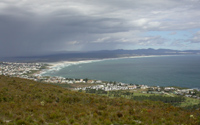
We took a late picnic lunch at the highest part of the estate, with the broad sweep of Walker Bay below us. Even at a distance, though through binoculars and telescope, it was easy to see the whales' backs and fins projecting from the water in many parts of the bay, and in fact the views from up here were somehow even more impressive than the close-up ones we had a little later from the seafront down in the town. But time was running out, and so it was on once more, over Sir Lowry's Pass (no time to look for Rockjumpers here) and down through the straggling suburbs of eastern Cape Town to get to the airport before dark. I was keen to get there with enough light to see the final target species, another 'import', this time from India, the House Crow. For once the traffic lights played ball, staying red at a road junction just before the airport long enough for me to focus my binoculars on a crow pulling apart some disgusting bag of rubbish adorning the gutter. Grey breast and nape contrasting with black wings and head – just enough time before the cars behind started hooting (though we saw a couple more in flight over the carpark where we left the hire car) to clinch a final tick. Darkness fell, so there was nothing more to do now but have a few drinks and something to eat, check our luggage in, and wait until gone midnight for the plane to take us on the long flight back to Amsterdam and Bristol.